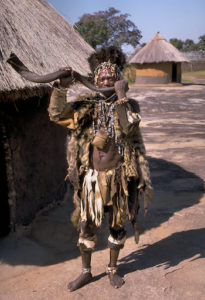
Shona Witch Doctor
On this date, 600 A.D., the Registry celebrates the Shona people of Africa. Located in Zimbabwe and southern Mozambique, their tribal language is also called Shona (Bantu), and their population is around 9 million.
There are five main Shona language groups: Korekore, Zeseru, Manyika, Ndau, and Karanga. The last of these groups was largely absorbed by the Ndebele when they moved into western Zimbabwe in the 1830s. Shona is linguistically related to the central Bantu and most likely moved into present-day Zimbabwe during the significant Bantu expansion.
Traditionally, Shona people live in isolated settlements with one or more elder men and their extended families. Most decisions are made within the family, although organized political states were recognized as a centralized power source. They were headed by a principal chief who inherited his position and power in the same divine manner as a king. He usually lived in a centralized location and was complemented by his court, which advised him about the most essential critical matters. The head chief often received substantial payment through tributes from his constituency.
The archaeological ruins, known as "Great Zimbabwe," date to approximately 600 A.D. It is believed that the ancestors of modern-day Shona built Great Zimbabwe and hundreds of other stone-walled sites in Zimbabwe. It was not until the late 19th century that the peoples of this area, speaking several mutually intelligible languages, were united under the Shona name. Although known for their stone sculpture, the Shona Tribe of Zimbabwe has a rich artistic heritage, including decorative fabric painting using sadza.
Sadza (pronounced sudza) is Maize, a primary basis of their diet. Maize (corn) is ground into a fine meal, which is then cooked with water until it is the consistency of mashed potatoes. Although eaten plain, sadza is often served with a vegetable or meat sauce to give it flavor. This painting technique uses sadza instead of wax as a medium between the different paint colors. After painting, the canvas is left to dry in the sun. Finally, the fabric is washed to remove the sadza, leaving a unique finished appearance. Designs often use traditional geometric patterns and stylized objects from everyday Shona life.
The Shona believe in two types of spirits. Shave spirits are often considered outside; wandering spirits and vadzimu are ancestor spirits. Shave spirits are connected to populations outside Shona territory and may be linked to neighboring peoples, Europeans, or animals. These spirits may be either malevolent or benevolent. Evil spirits are associated with witchcraft, while good spirits may inspire individual talents associated with healing, music, or artistic ability. Vadzimu represents all that is ideal and moral about a Shona way of life. They are usually related to recent ancestors or more remote cultural heroes whose exact genealogy has been forgotten. They serve to protect society, but may withdraw this protection if the Shona moral ideals are not respected.
The Soul of Mbira: Music and Traditions of the Shona People of Zimbabwe
by Paul F. Berliner
ISBN: 0226043797